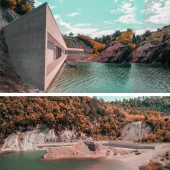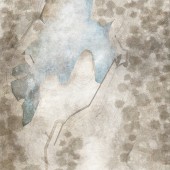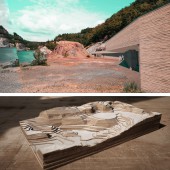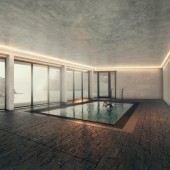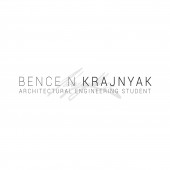Follower Form Diver Base of Rudabánya by Bence N. Krajnyák |
Home > Winners > #74549 |
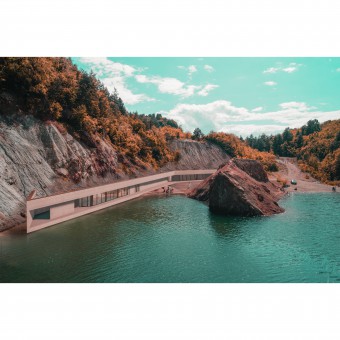 |
|
||||
| DESIGN DETAILS | |||||
| DESIGN NAME: Follower Form PRIMARY FUNCTION: Diver Base of Rudabánya INSPIRATION: Rudabanya is a small city located in the northern part of Borsod-Abauj-Zemplen county. The city is famous for its one-time ironstone mining activities, which finally ended in 1985. The quarry pond lies in the artificial basin of the late mine, said to be one of the deepest lakes of Hungary. The water temperature is quite cold therefore it suits well for practicing rescue divers as well for learning other deep diving activities thanks to the depths and dangers of the lake. UNIQUE PROPERTIES / PROJECT DESCRIPTION: The artificial intervention significantly transformed the character of the once untouched landscape, then the altered terrain has gradually been recaptured by nature. The purpose of the planned building is to influence this effect as little as possible. For this reason, the scale of the intervention made an important part of the conception. Looking for suitable processes for desinging has led to landcraping. As a result, we do not talk about designing a buliding but designing enviroment. OPERATION / FLOW / INTERACTION: The key elements are the location and the appearance (form). The chosen site was the scarp near the water because it provided a great opportunity to use landscraping properly and the connection between the water and base at the same time. The form of the bulinding follows the terrain that surrounds. The result is a mass that conforms itself to the landcape and fitting to the system of the recaptured nature. Following the line of the scarp, the result was an elongated form. This was organized by three different aspects. Firstly, a tempered part was created on the inner side of the buliding, hidden by covered outer spaces with different functions. Secondly, the main approach had to be given. Given the form, the main entrance was placed in the central part of the building. Lastly, the rooms and spaces of the base can be grouped into four different systems: rooms that do and ones that do not inquire light, parking function (which has to be hidden) and the most important part of the diver base, the ”road to diving”. The correspondence with the environment is also enhanced by the materials used in design, meaning that most of the exposed and visible surfaces and the structures too were made of (reinforced) concrete. PROJECT DURATION AND LOCATION: The project started in January 2018 in Budapest and finished in July. It was exhibitied in Budapest as well in November 2018. FITS BEST INTO CATEGORY: Architecture, Building and Structure Design |
PRODUCTION / REALIZATION TECHNOLOGY: The base was planned on the southwestern part of the lake which area is more shallow and even warmer in summer time than the other parts of it. Therefore it serves not just rescue divers, but any open water divers or totally junior divers too. It took many various and special technologies in several ways in order to realize the building. Securing the excavation pit from the mass of the scarp was conceived using steel sheet wall piling. Buliding above the water inquires special concrete placing methods and drilling precast concrete piles for foundation. For the deep pools constructed of reinforced concrete, a special waterproofing system is needed. Besides the appearance of the base aspires simplycity and sobriety, therefore where it was possible, the raw finished reinforced concrete structure stands rough. In consideration of the location it was subservient to take increased care for designing questions touching protection. Ones that were solved by applying massive, reinforced concrete pusher-gates and windows with quite narrow width. In this way the base can be absolutely closed if it is not in service. SPECIFICATIONS / TECHNICAL PROPERTIES: In a this natural enviromental situation, the site area was not determined. The location is a quarry pond. The diver base is a one-level building, its extension is 125 m through the longer direction and 33 m perpendicularly. The area of the base is 1600 sqm and the height of facade is 4,75 m. TAGS: Architecture, Landscape, Landscraping, Hungary, Diver Base, Water, Concrete RESEARCH ABSTRACT: Learning the site and surroundings, i had great use of the book of Landscrapers by Aaron Betsky getting to learn methods of ethical human intervention on the land. The finished plan inquired accented attentions touching enivronmentally friendly and cost-efficient building process and choice of materials used. The special location demands special applied systems. This statement includes the working of the buliding in a sustainable way: either the conscious management of the water from the lake, or recycling greywater, even applying biologycal sewage treatment systems for instance. CHALLENGE: Making an huge-scale intervention into an environment which is recaptured by nature and fitting it as much as it is possible. The result is a form that follows the line of the scarp through the connecting edge of the plain and slope parts. The spaces and rooms of the buliding are well-useable, they are connected to the water, yet the base feels reserved as well. By its roof the arriving touring people can discover inexperienced lanes. The purpose of the project was to design a fitting, more adaptable intervention. By which the location can gain a new interpretation which ultimately can lead to the prosperity of local tourism and the proper use of the site. ADDED DATE: 2019-01-22 15:22:33 TEAM MEMBERS (1) : IMAGE CREDITS: Nándor Bence Krajnyák, 2018. PATENTS/COPYRIGHTS: Copyrights belong to Nándor Bence Krajnyák, 2018. |
||||
| Visit the following page to learn more: http://www.behance.net/bencenkrajnyak | |||||
| AWARD DETAILS | |
 |
Follower Form Diver Base of Rudabánya by Bence N. Krajnyák is Winner in Architecture, Building and Structure Design Category, 2018 - 2019.· Read the interview with designer Bence N. Krajnyák for design Follower Form here.· Press Members: Login or Register to request an exclusive interview with Bence N. Krajnyák. · Click here to register inorder to view the profile and other works by Bence N. Krajnyák. |
| SOCIAL |
| + Add to Likes / Favorites | Send to My Email | Comment | Testimonials | View Press-Release | Press Kit |
Did you like Bence N. Krajnyák's Architecture Design?
You will most likely enjoy other award winning architecture design as well.
Click here to view more Award Winning Architecture Design.


